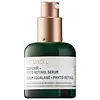What's inside
What's inside
 Key Ingredients
Key Ingredients

 Benefits
Benefits

 Concerns
Concerns

 Ingredients Side-by-side
Ingredients Side-by-side

Water
Skin ConditioningSqualane
EmollientNiacinamide
SmoothingSodium Acrylates Copolymer
Bakuchiol
AntimicrobialSodium Hyaluronate
HumectantRosa Canina Fruit Oil
EmollientCitrus Aurantium Amara Peel Oil
Skin ConditioningBiosaccharide Gum-1
HumectantYeast Extract
Skin ConditioningSoy Amino Acids
Skin ConditioningLecithin
EmollientHexylene Glycol
EmulsifyingEthylhexylglycerin
Skin ConditioningCaprylyl Glycol
EmollientPhenoxyethanol
PreservativeTetrasodium Glutamate Diacetate
Citric Acid
BufferingLinalool
PerfumingGeraniol
PerfumingLimonene
PerfumingWater, Squalane, Niacinamide, Sodium Acrylates Copolymer, Bakuchiol, Sodium Hyaluronate, Rosa Canina Fruit Oil, Citrus Aurantium Amara Peel Oil, Biosaccharide Gum-1, Yeast Extract, Soy Amino Acids, Lecithin, Hexylene Glycol, Ethylhexylglycerin, Caprylyl Glycol, Phenoxyethanol, Tetrasodium Glutamate Diacetate, Citric Acid, Linalool, Geraniol, Limonene
Camellia Sinensis Leaf Water
MaskingCoco-Caprylate
EmollientGlycerin
HumectantHelianthus Annuus Seed Oil
EmollientSimmondsia Chinensis Seed Oil
EmollientCetearyl Olivate
Sorbitan Olivate
EmulsifyingHydrogenated Jojoba Oil
AbrasiveWater
Skin ConditioningCetearyl Alcohol
EmollientCetyl Palmitate
EmollientLactic Acid
BufferingGlyceryl Caprylate
EmollientHippophae Rhamnoides Fruit Oil
Skin ProtectingSorbitan Palmitate
EmulsifyingXanthan Gum
EmulsifyingHydrogenated Soybean Oil
EmollientSorbitan Oleate
EmulsifyingSodium Hydroxide
BufferingLinalool
PerfumingCoriandrum Sativum Seed Oil
EmollientCaprylhydroxamic Acid
Coriandrum Sativum Fruit Extract
AntimicrobialOryza Sativa Bran Wax
Skin ConditioningRosa Canina Fruit Extract
AstringentSalvia Hispanica Seed Extract
EmollientCopaifera Officinalis Resin Oil
MaskingAmyris Balsamifera Bark Oil
MaskingAloe Barbadensis Leaf Juice
Skin ConditioningTocopherol
AntioxidantPersea Gratissima Oil
Skin ConditioningDaucus Carota Sativa Seed Oil
EmollientEucalyptus Globulus Leaf Oil
PerfumingOriganum Vulgare Leaf Oil
MaskingRosmarinus Officinalis Leaf Oil
MaskingGlycosphingolipids
EmollientGlycolipids
Skin ConditioningBeta-Sitosterol
Emulsion StabilisingSodium Hyaluronate
HumectantLimonene
PerfumingSqualene
EmollientVaccinium Macrocarpon Fruit Extract
AstringentGeraniol
Perfuming1,2-Hexanediol
Skin ConditioningCaprylyl Glycol
EmollientRosmarinus Officinalis Leaf Extract
AntimicrobialCamellia Sinensis Leaf Water, Coco-Caprylate, Glycerin, Helianthus Annuus Seed Oil, Simmondsia Chinensis Seed Oil, Cetearyl Olivate, Sorbitan Olivate, Hydrogenated Jojoba Oil, Water, Cetearyl Alcohol, Cetyl Palmitate, Lactic Acid, Glyceryl Caprylate, Hippophae Rhamnoides Fruit Oil, Sorbitan Palmitate, Xanthan Gum, Hydrogenated Soybean Oil, Sorbitan Oleate, Sodium Hydroxide, Linalool, Coriandrum Sativum Seed Oil, Caprylhydroxamic Acid, Coriandrum Sativum Fruit Extract, Oryza Sativa Bran Wax, Rosa Canina Fruit Extract, Salvia Hispanica Seed Extract, Copaifera Officinalis Resin Oil, Amyris Balsamifera Bark Oil, Aloe Barbadensis Leaf Juice, Tocopherol, Persea Gratissima Oil, Daucus Carota Sativa Seed Oil, Eucalyptus Globulus Leaf Oil, Origanum Vulgare Leaf Oil, Rosmarinus Officinalis Leaf Oil, Glycosphingolipids, Glycolipids, Beta-Sitosterol, Sodium Hyaluronate, Limonene, Squalene, Vaccinium Macrocarpon Fruit Extract, Geraniol, 1,2-Hexanediol, Caprylyl Glycol, Rosmarinus Officinalis Leaf Extract
 Reviews
Reviews

Ingredients Explained
These ingredients are found in both products.
Ingredients higher up in an ingredient list are typically present in a larger amount.
Caprylyl Glycol is a humectant and emollient, meaning it attracts and preserves moisture.
It is a common ingredient in many products, especially those designed to hydrate skin. The primary benefits are retaining moisture, skin softening, and promoting a healthy skin barrier.
Though Caprylyl Glycol is an alcohol derived from fatty acids, it is not the kind that can dry out skin.
This ingredient is also used as a preservative to extend the life of products. It has slight antimicrobial properties.
Learn more about Caprylyl GlycolGeraniol is used to add fragrance/parfum to a product. It is the main component of citronellol. It is a monoterpenoid and an alcohol.
Monoterpenes are naturally found in many parts of different plants.
Geraniol can be found in many essential oils including Rose Oil and Citronella Oil. The scent of Geraniol is often described as "rose-like". Many foods also contain Geraniol for fruit flavoring.
Geraniol can irritate the skin when exposed to air. However, irritation depends on the ability of geraniol to penetrate into the skin. In general, geraniol is not able to penetrate skin easily.
Geraniol is colorless and has low water-solubility. However, it is soluble in common organic solvents.
Like citronellol, it is a natural insect repellent.
2,6-Octadien-1-ol, 3,7-dimethyl-, (2E)-
Learn more about GeraniolLimonene is a fragrance that adds scent and taste to a formulation.
It's found in the peel oil of citrus fruits and other plants such as lavender and eucalyptus. The scent of limonene is generally described as "sweet citrus".
Limonene acts as an antioxidant, meaning it helps neutralize free radicals.
When exposed to air, oxidized limonene may sensitize the skin. Because of this, limonene is often avoided by people with sensitive skin.
The term 'fragrance' is not regulated in many countries. In many cases, it is up to the brand to define this term. For instance, many brands choose to label themselves as "fragrance-free" because they are not using synthetic fragrances. However, their products may still contain ingredients such as essential oils that are considered a fragrance.
Learn more about LimoneneLinalool is a fragrance and helps add scent to products. It's derived from common plants such as cinnamon, mint, citrus, and lavender.
Like Limonene, this ingredient oxidizes when exposed to air. Oxidized linalool can cause allergies and skin sensitivity.
This ingredient has a scent that is floral, spicy tropical, and citrus-like.
Learn more about LinaloolSodium Hyaluronate is hyaluronic acid's salt form. It is commonly derived from the sodium salt of hyaluronic acid.
Like hyaluronic acid, it is great at holding water and acts as a humectant. This makes it a great skin hydrating ingredient.
Sodium Hyaluronate is naturally occurring in our bodies and is mostly found in eye fluid and joints.
These are some other common types of Hyaluronic Acid:
Learn more about Sodium HyaluronateWater. It's the most common cosmetic ingredient of all. You'll usually see it at the top of ingredient lists, meaning that it makes up the largest part of the product.
So why is it so popular? Water most often acts as a solvent - this means that it helps dissolve other ingredients into the formulation.
You'll also recognize water as that liquid we all need to stay alive. If you see this, drink a glass of water. Stay hydrated!
Learn more about Water